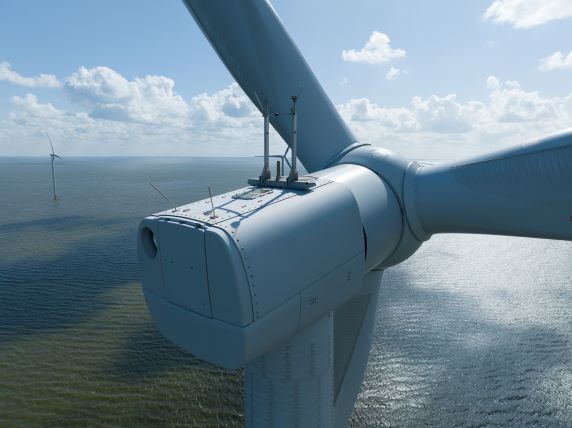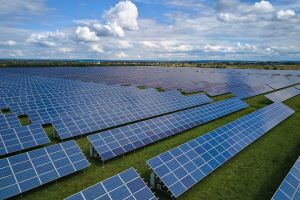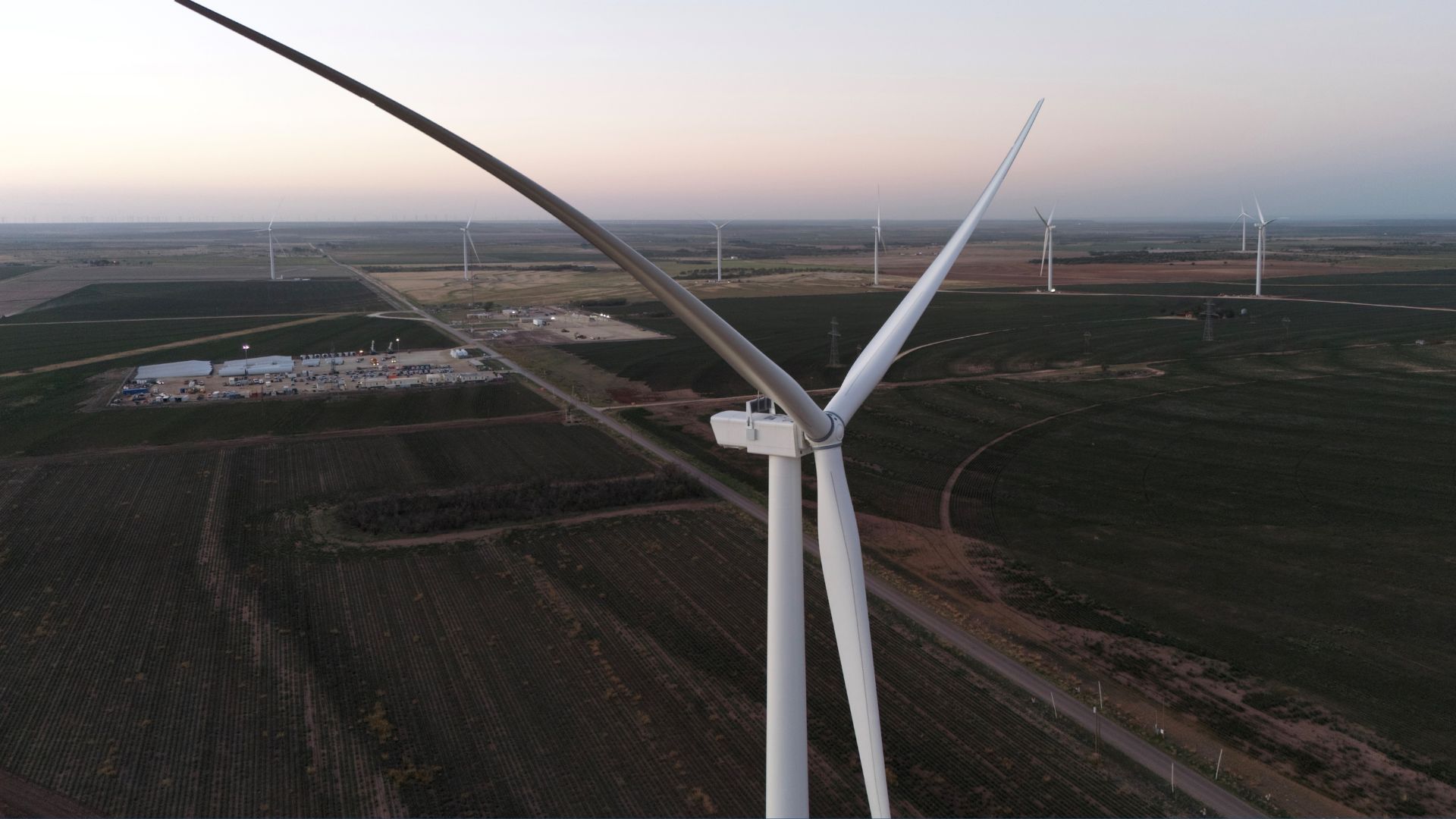Dominion Energy is nearly halfway complete with the $9.8 billion Coastal Virginia Offshore Wind (CVOW) project, having wrapped up its first monopile installation season and lowered the project’s levelized cost of electricity (LCOE) estimates.
The 2.6-gigawatt (GW) CVOW—the largest U.S. offshore wind project being developed—remains on time and on budget for completion in late 2026, the company reported Nov. 1. Construction is 43% complete. So far, about $5.3 billion has been spent on the project and that is expected to reach about $6 billion by year’s end.
“We just completed a very successful first monopile installation season. ... We’ve installed 78 monopoles as well as four pin piles which support the first of three planned offshore substations,” Dominion Energy CEO Robert Blue said Nov. 1 on the company’s third-quarter 2024 earning call. “Additionally, we’ve laid the first two of nine marine deepwater export cables ahead of schedule. I’m very pleased with our progress during this first season. Not only did we achieve our installations target, we also gained invaluable experience and process expertise that will make the next installation season even more productive.”

The wind project is taking shape as the U.S. aims to grow offshore wind capacity to 30 GW by 2030. The progress is a positive for an offshore U.S. wind sector that has endured challenges concerning the supply chain, interest rates and inflation.
Dominion, which has fared better than some of its peers, brought in infrastructure investor Stonepeak as its CVOW partner in a $2.6 billion deal.
When complete, the 176-turbine offshore wind farm with three offshore substations is expected to provide enough power for about 660,000 homes.
Developers also brought down the project’s LCOE to $56 per megawatt hour (MWh), compared to $73/MWh in May and between $80 and $90 originally estimated. The primary driver, Blue said, was forecasted renewable energy credit (REC) prices. “Keep in mind that higher REC prices are credit against the levelized cost of energy as value delivered to customers.”
Dominion also submitted its 2024 offshore wind rider filing Nov. 1 for the project. It includes an annual revenue of $640 million.
“For the next few months, the company will focus on installation of the first offshore substation, continued export cable lays and onshore transmission construction and placement of transition pieces on top of monopiles in preparation for turbine installation starting in 2025,” it said.
Here’s a look at other renewable energy news.
Energy storage
Equinor, Standard Lithium JV Sign DLE Agreement
Standard Lithium and Equinor’s joint venture (JV) company SWA Lithium entered a license agreement to use Koch Technology Solutions (KTS) technology for the JV’s South West Arkansas Phase 1 project, according to a news release.
The commercial-scale direct lithium extraction (DLE) project will use KTS’ Li-Pro Lithium Selective Sorption technology at the JV’s commercial plant, Standard Lithium said in a news release.
“The Li-Pro LSS technology is now sufficiently scaled-up, tested and derisked, so not only is the JV comfortable committing to its use at commercial scale,” said Andy Robinson, Standard Lithium’s director, president and COO, “but KTS is also able to offer performance guarantees for its commercial deployment. We view this as a significant derisking event for the project, and it points to the successful ongoing partnership with the KTS team.”
The license agreement is the culmination of more than two years of work, Robinson said.
UK Investment Firm Low Carbon Sells 6-GW Dutch Battery Storage portfolio
(Reuters) U.K.-based renewable energy investor Low Carbon said it has sold a 6-GW portfolio of battery storage projects in the Netherlands to S4 Energy, which is majority-owned by global commodities merchant Castleton Commodities International (CCI).
The battery storage portfolio is one of the largest under development in the world, according to Low Carbon, and should play a role in helping balance supply and demand on the grid system as the Netherlands seeks to have 39% of renewables in its total energy mix by 2030.
The battery storage projects have been developed by LC Energy, a JV between Low Carbon and Dutch engineering firm QING, and have been sold to Dutch energy storage developer and operator S4 Energy, which CCI took a majority stake in last year.
Low Carbon aims to deliver 20 GW of low-carbon energy globally. It has around 16 GW of capacity currently under development.
“Some assets we will hold onto as an independent power producer—some assets we will choose to recycle capital from so we can deliver more investment in clean energy,” Low Carbon’s CEO Roy Bedlow told Reuters.
The battery storage portfolio is comprised of early, mid- and advanced-stage developments, Low Carbon said. The firm would not disclose the financial details of the deal.
Solar
Enbridge Takes FID on Sequoia Solar, Advances Fox Squirrel Solar

Houston-based Enbridge has sanctioned its $1.1 billion Sequoia solar project west of Dallas, the company said Nov. 1., having lined up power purchase agreements (PPAs) with AT&T and Toyota.
The 815-MW solar farm will be developed in two phases and is expected to enter service in 2025 and 2026, the company said in its third-quarter 2024 earnings release.
The energy infrastructure company known for transporting and distributing oil, natural gas and NGL has been growing its presence in the renewable energy and power sector. Enbridge has interest in more than 2.5 GW of net renewable generating capacity across North America, according to the company’s website.
“In renewable power, we continue to execute on our disciplined growth strategy,” Enbridge CEO Greg Ebel said in the release.
During third-quarter 2024, the company and partner EDF Renewables put the 250-MW Fox Solar Phase II project into service in Ohio. Construction of the 177-MW Phase III is underway, and the project is scheduled to enter service in the fourth quarter. A long-term PPA is in place with Amazon for 100% of the solar farm’s production, Enbridge said.
Recurrent Energy Flips Switch on Texas Solar Project
Canadian Solar subsidiary Recurrent Energy has started operations at its 134-MW Liberty solar project near Houston, the parent company said Oct. 31.
Located in Liberty County northeast of Houston, the solar farm will produce enough electricity to power about 15,000 homes annually and will expand energy capacity in the Midcontinent Independent System Operator market, Canadian Solar said.
“We are thrilled to complete this project on time and on budget in support of the renewable energy goals of our customers,” Recurrent Energy CEO Ismael Guerrero said.
Customers include Autodesk Inc., Biogen Inc., EMD Electronics and Wayfair Inc.
Rabobank, Nord LB and U.S. Bank subsidiary U.S. Bancorp Impact Finance provided the construction loan for the project, according to the release. U.S. Bancorp Impact Finance is also providing $80 million in tax equity for the project.
In a separate news release Oct. 31, Canadian Solar said Recurrent will deliver 150 MW of solar capacity and 1,800 MWh of energy storage to Arizona Public Service Co. The arrangement is part of 20-year tolling agreements for power from the 600-MWh Desert Bloom standalone storage project and the 150-MW Papago Solar project in Arizona’s Maricopa County. The company said construction will begin next year for the two projects with both scheduled to begin operations in 2026.
BP Spun Off Part of US Operations of Solar JV Lightsource BP
(Reuters) BP spun off part of the U.S. operations of its Lightsource BP solar joint venture shortly before completing the acquisition of the outstanding 50% stake in the business last week, the British company said Oct. 29.
“Immediately prior to the business combination, 2.4 GW of Lightsource BP’s operational and construction assets in the United States were transferred from Lightsource BP into a new joint venture between BP and the Lightsource BP founders, and certain management and staff,” BP said in its third-quarter results.
The sides agreed on the move due to the recent drop in valuations for solar projects in the U.S., a source close to the deal said.
CFO Kate Thomson told Reuters that BP planned to sell a stake in Lightsource BP to investors to help reduce BP's investment burden and debt in the business.
RELATED
KKR, Solar Developer Birch Creek Close $150MM Credit Facility
First Solar’s Profit Rises Despite Chinese Dumping, Patent Disputes
Hydrogen
Advanced Ionics, Lummus Form Green Hydrogen Partnership
Hydrogen tech startup Advanced Ionics landed support from Lummus Technology as the startup takes steps to speed commercialization of its hydrogen electrolyzer technology.
As part of the green hydrogen partnership announced Nov. 1, Lummus will provide Advanced Ionics with engineering services and supply proprietary equipment to add green hydrogen capacity for newbuilds and existing hydrogen users or producers, according to a news release. Lummus Venture Capital is also investing in the company.
“Lummus has a proven track record of serving as a launchpad for innovative technologies,” said Lummus Technology CEO Leon de Bruyn. “With Advanced Ionics, we will leverage this experience to develop and deploy cost-efficient solutions that advance green hydrogen production and help decarbonize key sectors of the downstream energy industry.”
Wisconsin-based Advanced Ionics’ Symbion electrolyzers use process or waste heat with temperatures from 100 C and higher, which helps reduce electricity costs. The electrolyzers can be scaled and use off-the-shelf components such as stainless steel and nickel instead of expensive catalysts like platinum or iridium, which also lowers costs.
“Water vapor electrolyzers address two of the biggest challenges to expanding decarbonized hydrogen production: capital costs and electricity requirements,” said Advanced Ionics CEO Chad Mason. “Our partnership with Lummus Technology—and their additional investment—marks a pivotal next step in accelerating the commercialization of technology, which was purpose-built for decarbonizing heavy industry.”
Wind
RWE, EV Maker Rivian Ink PPA for Champion Wind Power

Renewable energy company RWE on Oct. 31 said it entered a 15-year power purchase agreemenet (PPA) with electric vehicle manufacturer Rivian.
The PPA is for electricity from the 127-MW Champion Wind Farm in the West Texas counties of Nolan and Mitchell, where RWE said repowering activities are underway to extend the facility’s lifetime. Rivian plans to use the electricity to power its fast-charging network. The upgrades, which include new nacelles and blades, are expected to be complete in mid-2025.
“RWE continues to pursue commercial opportunities to partner with leading innovative companies like Rivian to help decarbonize the grid,” RWE Clean Energy Chief Commercial Officer Christoph Hunfeld. “We are investing in clean energy projects to support the needs of energy-intensive companies, and PPAs like this one with Rivian facilitate those investments.”
Originally commissioned in 2008, Champion Wind will generate enough electricity to
power the equivalent of 36,000 homes annually in Texas. RWE said it is partnering with M.A. Mortenson Co. on the project, and Siemens Gamesa is supplying nacelles and blades for 41 turbines.
Plans are to repurpose the wind blades as fiber mesh additive into concrete and asphalt, RWE said.
Ørsted Sells Stakes in Four UK Offshore Wind Farms to Brookfield
(Reuters) Denmark’s Ørsted said on Oct. 30 it had agreed to sell a 12.45% minority stake in four of its operational British offshore wind farms to Brookfield in a transaction worth 1.75 billion pounds (US$2.28 billion).
“Today’s transaction is an important milestone in the farm-down program as part of our business plan, supporting our significant re-investment in new assets,” Ørsted CEO Mads Nipper said in a statement.
Battling to restore investor confidence, Ørsted in February trimmed its investment and capacity targets and paused dividend payouts as part of a major review.
The transaction, which includes stakes in the Hornsea 1, Hornsea 2, Walney Extension and Burbo Bank Extension projects, is expected to close by the end of this year.
“This is Brookfield’s first investment in U.K. offshore wind, which will continue to be a critical part of the energy mix and to support the growing demand we see for clean energy,” Connor Teskey, CEO of Brookfield Renewable and President of Brookfield Asset Management, said in the statement.
Ørsted will retain a 37.55% ownership interest in the wind farms, it said.
RELATED
US Offshore Wind Lease Sale Brings in Nearly $22MM in Winning Bids
Reuters and Hart Energy Staff contributed to this report.
Recommended Reading
Phillips 66’s NGL Focus, Midstream Acquisitions Pay Off in 2024
2025-02-04 - Phillips 66 reported record volumes for 2024 as it advances a wellhead-to-market strategy within its midstream business.
Not Sweating DeepSeek: Exxon, Chevron Plow Ahead on Data Center Power
2025-02-02 - The launch of the energy-efficient DeepSeek chatbot roiled tech and power markets in late January. But supermajors Exxon Mobil and Chevron continue to field intense demand for data-center power supply, driven by AI technology customers.
Plains All American Prices First M&A Bond of Year
2025-01-13 - U.S. integrated midstream infrastructure company Plains All American Pipeline on Jan. 13 priced a $1 billion investment-grade bond offering, the year's first to finance an acquisition.
EnLink Investors Vote in Favor of ONEOK Buyout
2025-01-30 - Holders of EnLink units voted in favor of ONEOK’s $4.3 billion acquisition of the stock, ONEOK announced Jan. 30.
Buying Time: Continuation Funds Easing Private Equity Exits
2025-01-31 - An emerging option to extend portfolio company deadlines is gaining momentum, eclipsing go-public strategies or M&A.
Comments
Add new comment
This conversation is moderated according to Hart Energy community rules. Please read the rules before joining the discussion. If you’re experiencing any technical problems, please contact our customer care team.





